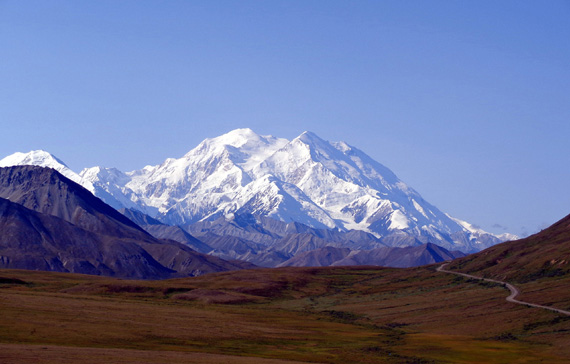There is a military RV park named Desert Rats at the Barstow, CA
Marine Corps Logistics Base. This isn't that. I'm just borrowing the
term as it's used to describe folks who live in the desert, even if it's
just for the winter.
The desert we're in is located about 25 miles north of Yuma, in far
southwestern Arizona. Our campground at the U.S. Army's Yuma Proving Ground (YPG)
is just a mile from the Colorado River, which separates Arizona from
California. When we drive to Yuma to shop, sightsee, visit our medical
providers, and run other errands we're mostly on the California side of
the river until we reach town:
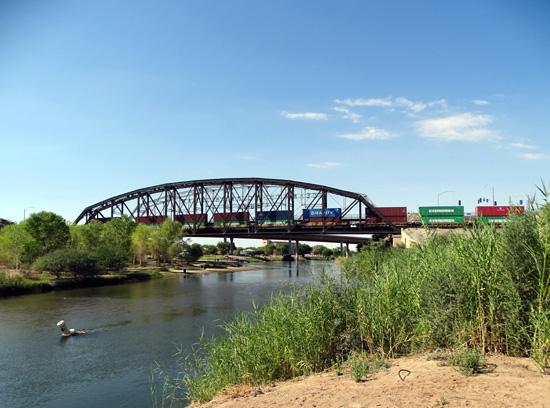
With all the agricultural irrigation along the river north of Yuma
it's a wonder there is any water left in it when it gets to town!
Four
winters ago we spent a little over two months at the nearby
Imperial Dam Long-Term Visitor Area (LTVA), a 5,000-acre chunk of BLM
land on the California side of the river where several thousand other
RVing snowbirds from all over North America came to bask in the warm
winter sun.
Here's a picture I took of some of the RVs from one
of the surrounding hills in January, 2012:
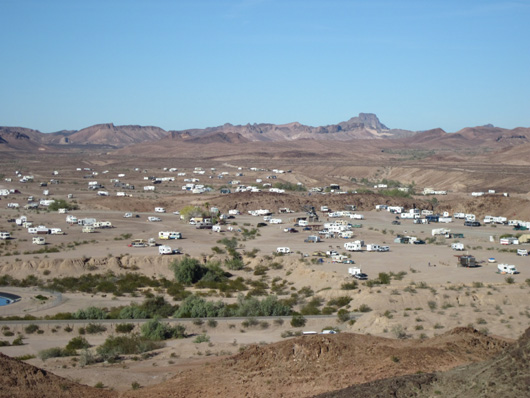
The cost was dirt cheap (pun intended) and we had about an acre to ourselves
but it was a lot of work to haul and dump water, etc. with no hookups.
We aren't getting any younger. These days we prefer to have water,
electrical, and sewer hookups, as well as reliable phone, internet, and
TV connections, especially when we're in one spot for several months.
So this winter we decided to try out the nice RV park at Yuma Proving
Ground, just a few miles east of Imperial Dam LTVA. We drove on-base
several times when we were a few miles away four years ago to ride our bikes
around the cantonment area (mostly housing and services, not secure work
areas), do laundry, check out the heritage museum, and use some of the
other facilities -- so we already knew what the campground looked like.
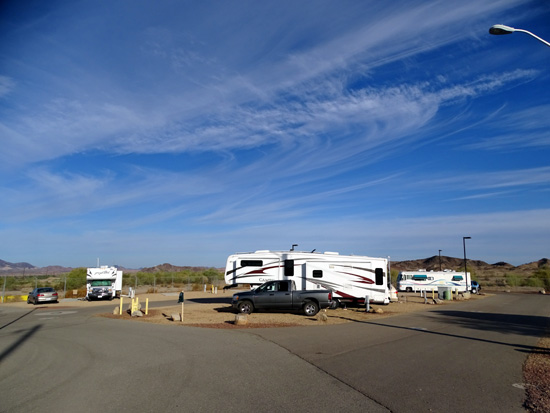
This is the back loop in the
newer part of the campground; we're in the middle, with few other
RVers settled in yet in late
October. The older section has more trees but smaller sites.
At just $375/month for full hookups, cable TV, and "free" WiFi,
Desert Breeze RV Park is a real bargain. It's less expensive than any other
military travel camps where we've stayed and has some features that even
more expensive ones don't have.
YPG doesn't have very many personnel living on base (most live in
Yuma) so services like the commissary
and veterinary clinic are more limited than most bases.
Some RVers
don't like having to go 20-25 miles to Yuma to get groceries and do
other shopping but we don't mind.
It's a pleasant drive through scenic and interesting orchards and produce and
date farms to get to town once or twice a week. This area is known for its
massive irrigated agricultural lands:
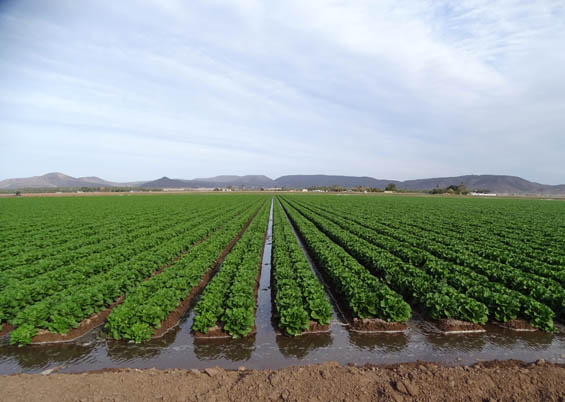
This stay turned out to be our longest in one place in the twelve
years we've been traveling in our RV -- October 25, 2015 to March
20, 2016, almost five full months.
It's not that we loved it that much at YPG or got inertia. In
fact, we were pretty tired of brown desert by the time we left. We timed
our departure because of weather considerations in the places
where we wanted to go next in the spring of 2016.
This entry covers information about YPG, camping at the RV park, and some of our
activities on base the last two months of this year.
I'll have three additional entries about our hiking and cycling
adventures in this area, more photos from produce fields and orchards,
a tour of one of the local date farms, and
visiting the only colorful desert locale we've found down here,
the Imperial Wildlife Refuge.
FROM PATTON TO THE PRESENT
It was a relatively short drive on October 25 from Black Canyon
City, AZ to Yuma Proving Ground via I-15, a bypass around the
west side of metro Phoenix, I-10 west, US 95 south, and Imperial Dam
Road.
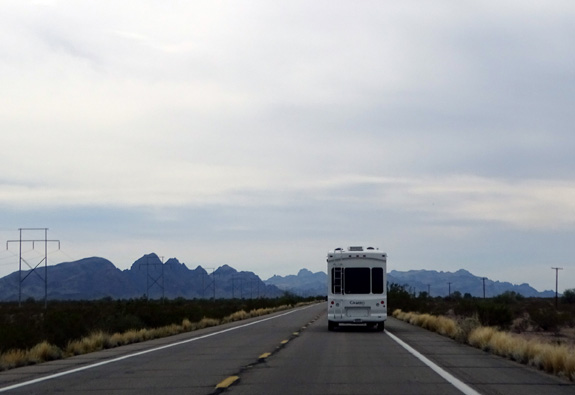
Heading south on US 95 through
Proving Ground territory; lots of jagged peaks in this desert.
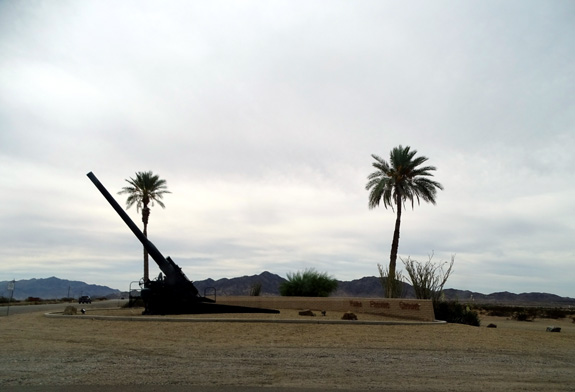
Sign for YPG at intersection of
US 95 and Imperial Dam Rd.
Because it is the "proving ground" for Army personnel, tanks, artillery,
and other equipment, YPG covers a LOT of desert territory -- well over
a thousand square miles.
Most of the military property is either
roadless or closed to the public but anyone can drive through the parts
of the base on
US 95, Imperial Dam Road, and the road to Martinez Lake and the Imperial
Wildlife Refuge.
The secure entrance gate for the cantonment area, which includes Desert
Breeze Travel Camp and base
housing, is about six miles west of US 95 on Imperial Dam Road. Although
the public is allowed through this gate to visit the heritage museum or
attend church and some special events, most of the time only people with
military IDs can get on base. Even with military IDs Jim and I can't
access any of the working/testing areas, though.
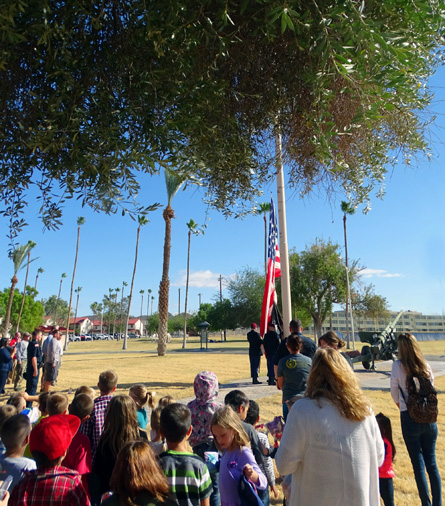
Above and below: Veteran's
Day ceremony near the heritage museum
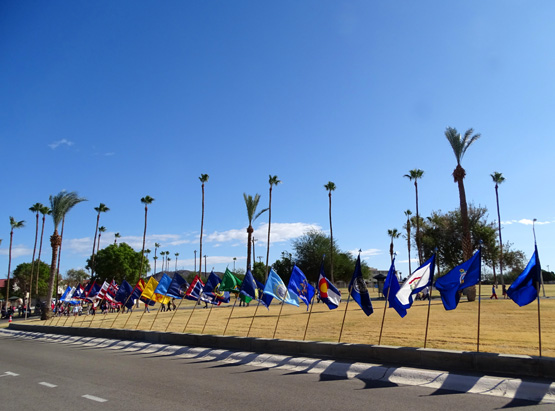
The Army first began using this location along the Colorado River at
Imperial Dam during WWII. Because engineers could control the flow of
the water, they were able to test the construction of portable bridges
used elsewhere in the war.
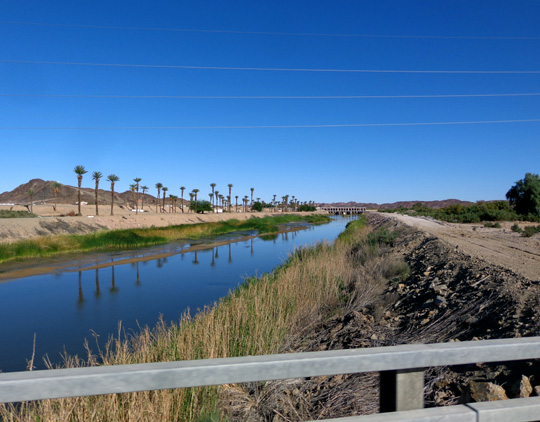
Above and below: two parts
of Imperial Dam; there are several canals along the
river and an interpretive sign that
tells the history of the portage bridges.
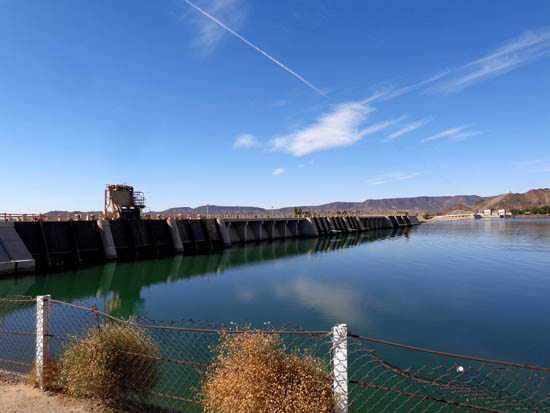
General Patton also used the vast surrounding desert to train more
than a million soldiers for combat.
After the war ended the Army has continued testing combat vehicles,
aircraft, and weapons systems, as well as personnel. It is one of the
largest military installations in the world. It is also home to the
Military Freefall School and GM's hot-weather test track.
With proper identification (vehicle registration, proof of insurance,
and photo ID), the general public can visit the YPG Heritage Center via
the same gate on Imperial Dam Road that is used to reach the RV park.
The museum has exhibits about the history and mission of the base from
the 1940s to the current day.
There is also a Marine base in Yuma which offers more veteran and
retired military services.
CAMPING AT YPG
Desert Breeze RV Park is relatively quiet, considering all the activity
occurring at this base. Sites are open to military active duty, National Guard,
reservists, retired, 100% disabled veterans, DoD civilians, and their
guests.
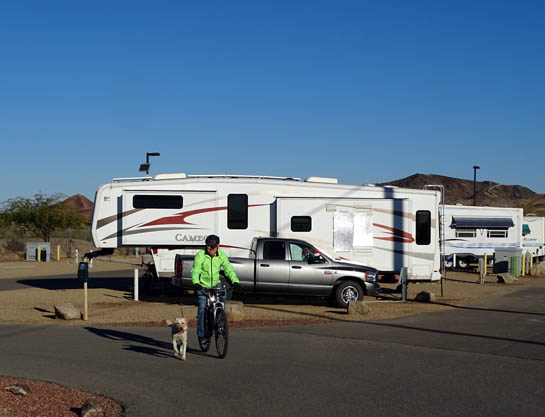
Jim and Casey begin a bike ride on base (that's our
Cameo behind them).
Although some folks reside in their RVs at Desert Breeze year-round for
their jobs on base, most of the sites are used in the cooler winter
months for recreation purposes, not base housing. There is another smaller
RV park on base for personnel living here temporarily or waiting for housing to
become available.
Reservations are not allowed in most cases** so we called periodically
before our arrival to make sure there were some spots available. We were
advised that the seasonal sites would probably fill by mid-November, so
we got here earlier to have more choice.
** A quirky exception is for snowbirds who are adamant about getting their
previous winter site. They can pay for both Sept. and Oct. to reserve
it, if available.
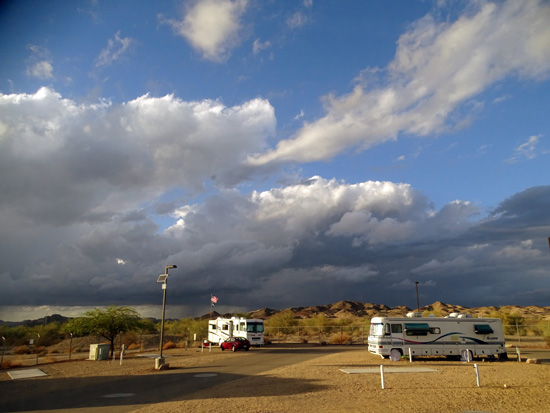
Our end of the loop was pretty empty when we
arrived in late October. That's a rare storm in
the distance. This area gets an average of only 3"
of rain annually and has 350 days of sunshine.
A few sites, including two with only water and electricity, are
designated for RVers wanting to stay for shorter periods of
time. This year the daily rate is $30 for full-hookup sites with 50-amp
electricity, water, sewer, WiFi, and cable TV. The weekly
rate is $130 and the monthly rate is an unbelievably low $375. That's
only $12.50/day!
By staying five months, we were able to save a lot of money even though
we drove about 25 miles each way down to Yuma once or twice a week to
shop and run errands. It's nice having the car to use for those trips so
we can save on fuel costs.
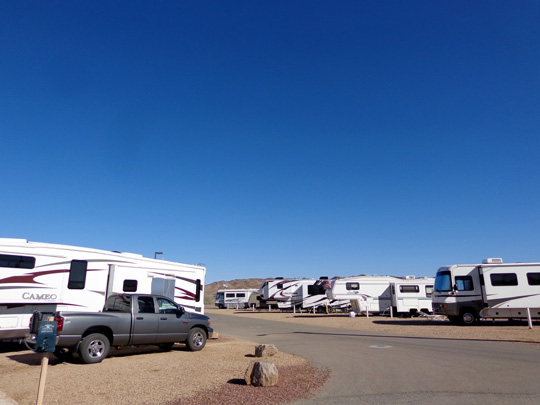
The row behind us was full by mid-November but a
few other sites were still available.
Before we headed for YPG we looked at Google Earth photos of the RV
park to try to determine how and where we'd want to be situated.
We know prevailing winds in the area are from the north and west. As
dry as this desert is, sand and dust often fly. ("Desert Wind"
is a more accurate name for the RV park than "Desert Breeze!")
Despite the wind we wanted our doorside to face north or east so
our patio would be in shade for more of the day:

Jim and Casey enjoy some shade
on our patio before the sun moves around there.
We seldom used our awning, even with tie-downs,
because of too much wind.
When we arrived on October 25 our first choices were already occupied by
seasonal guests but about 80% of the full-hookup sites were available.
That still gave us lots of options. It's a pain to move a 5th-wheel from
one site to another so we found what we hoped would be a suitable site
in the farthest loop and stayed put for five months.
Our large pull-through site at the end of a row has plenty of room for the
Cameo, truck, and minivan with no one on our off-doorside, which faces SE.
It has been very quiet on the farthest loop, we have interesting views of the hills
to the north, and the WiFi, phone, and TV signals are strong.

There are a few downsides, however -- no large trees in this newer
section of the campground to provide shade, some strong winds
from the NW on our doorside, lots of sun on the patio in the late
afternoon (but great views of colorful sunsets from the window by my
desk),
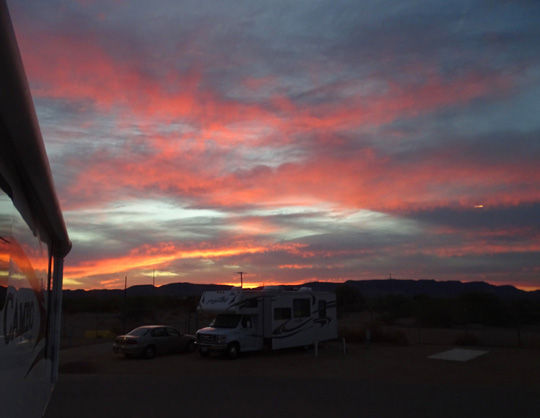
and too much sun on the other side for the refrigerator to operate
properly when we first arrived and temps were still in the 80s and 90s
F.
Like a few other park residents, we taped some foam
insulation over the outer wall behind the refrigerator for more efficient cooling.
The refrigerator was still vented, the insulation wasn't terribly
obvious, and -- most importantly -- it solved the problem:
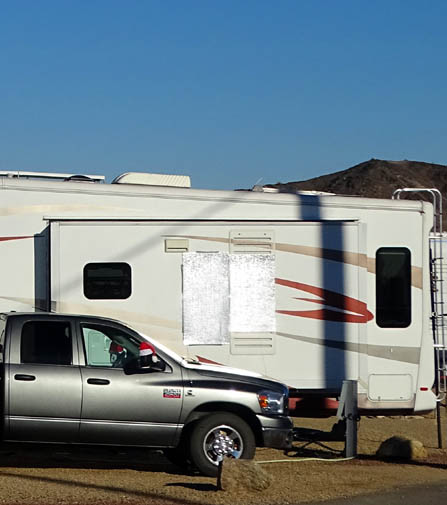
In late October we were one of the first to occupy a site in the far back loop. By
the end of November it was mostly full and remained so until March,
when folks began heading north because it was starting to get hot again.
Roads in the campground are paved, which is good. All sites are
gravel with a large concrete pad for RVs plus patio. There are no
picnic tables, which is a little unusual for a military RV park. Most of
us have potted plants outside to add some color to our sites. I had some
yellow mums in the fall and red geraniums in the spring:
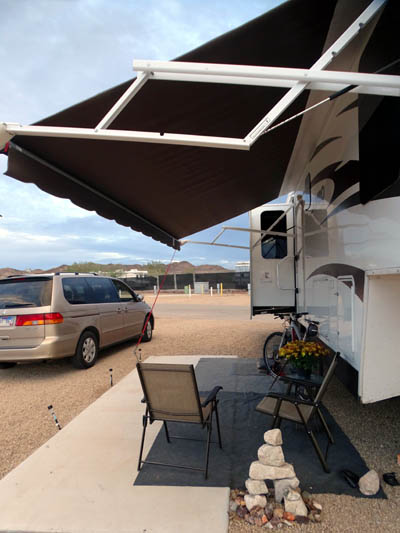
I also built a little Inukshuk
with colorful rocks I found during hikes.
Canadians use these people shapes
as cairns on trails and I just like them.
The desert floor and mountains in far southwestern Arizona are mostly
brown, with less color and fewer green plants than the deserts near
Phoenix and Tucson. The most color is found in the beautiful green
fields full of vegetables and some cacti that bloom in the spring.
Desert Breeze has a large activity building housing the campground office,
large spaces for lounging and potluck dinners, a game room, and mailboxes. Each
site has a designated slot in a room next to the office for USPS mail, which is
convenient.
Private carriers like UPS and FedEx deliver packages
directly to our door -- even nicer! We had a bit of a problem when REI sent
a new bicycle seat via a different carrier we'd never heard of. The delivery guy
didn't have proper ID to get on base but we eventually got the package.

Sometimes we could
see wandering wild burros (above) and bighorn
sheep (below) next to the fence surrounding our part of the RV park.
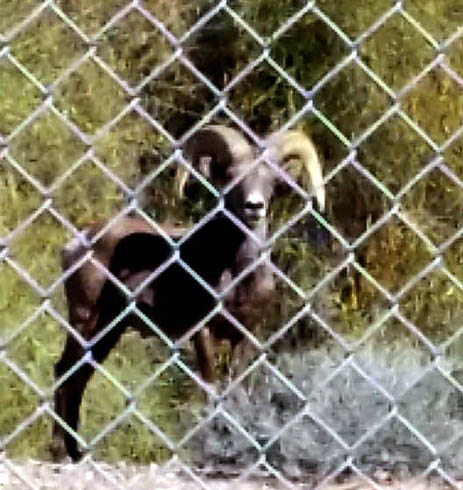
Campground residents also have access to a large laundry room with showers near the
center of the campground. All the washers and dryers are usually in good working order.
They aren't free like at some military RV parks but the cost is much lower than a
commercial Laundromat.
There is an additional laundry room in the building
housing the NEX shoppette and fuel station. We used that when we camped at the
LTVA four years ago. Note that there is no diesel for visitors in this area on base,
just gasoline and propane.
AROUND THE BASE
Although the part of YPG to which we have access is smaller than some other military
installations where we've stayed, there are several miles of paved streets that are safe for
us to ride our bikes and walk the dogs.
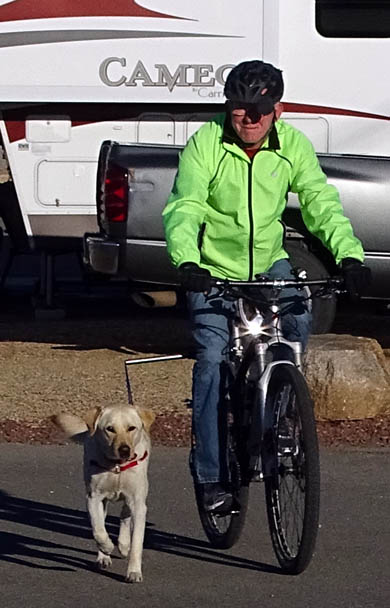
Jim rides with Casey about five
miles a day
with the "Walky Dog"
attachment.
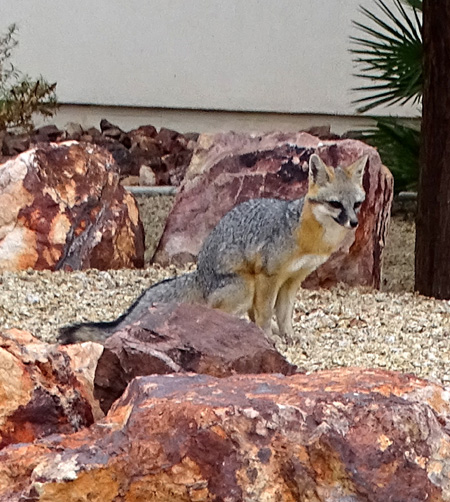
On just about every ride Jim and Casey see one or
more foxes in the
housing area and by the library. Coyotes also roam
the surrounding hills.
Because of base security I'm limited in what photos I have been
able to take even in the cantonment area so I'm using a lot of discretion
in what I'm showing here.
We enjoyed riding and walking through the housing area, especially when the
houses and grounds were decorated for Christmas,
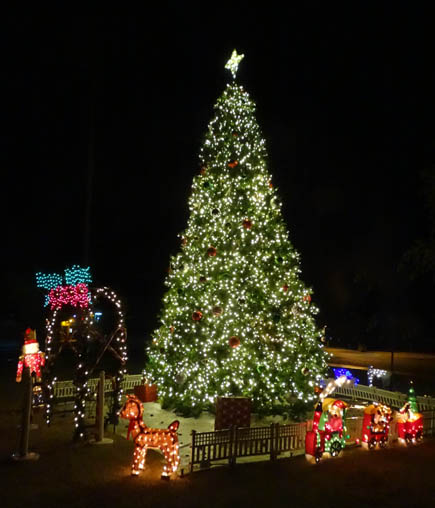
and through Cox Field, a large grassy area with ball fields. There
isn't much grass in the desert!
There are several small parks and playgrounds on base, as well as a nice
fenced dog park with grass, water, some agility equipment, and canopies. Casey
enjoyed playing ball there either by herself or with other dogs:
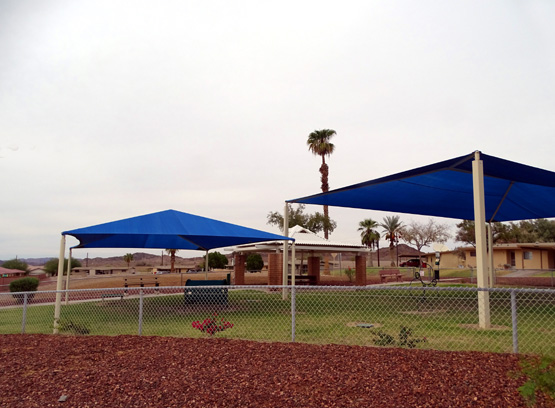
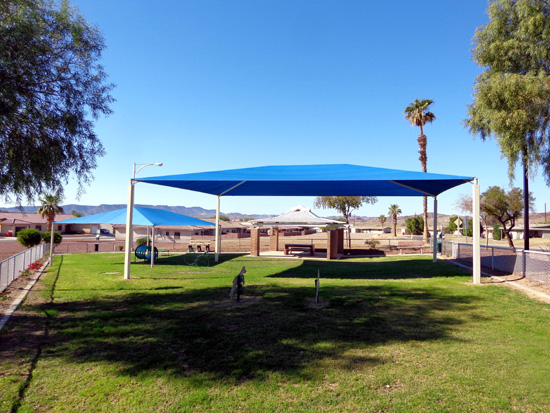
There is also a hilly, mile-long sandy trail through one of the
parks where I can walk the dogs:
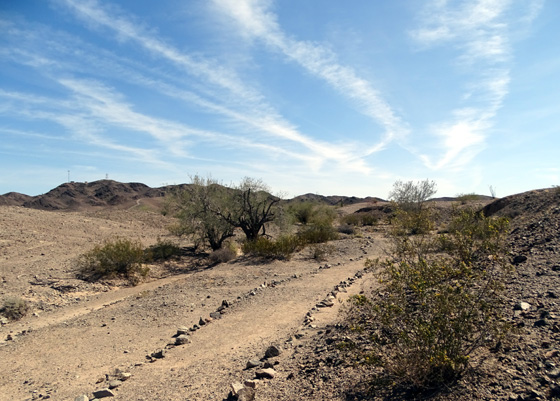
We found different things to look at on nearly every walk and
ride on base.
Close to the heritage museum, for example, is the
engine for the Army's "Overland Train" and a sign that explains
its use:
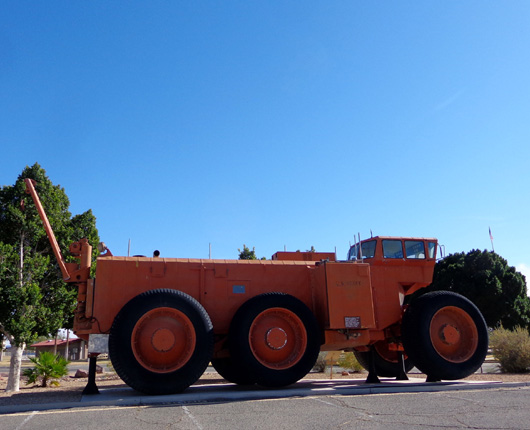
The train was developed in the early 1960s to transport troops,
supplies, and equipment slowly for up to 400 miles both on and off-road,
including rough, uneven terrain. The control car shown above could haul
ten cargo cars and two power-generating cars, as well as provide living
quarters for six crew people inside.
It's very convenient to just walk right from our campsite and not have to
drive somewhere, although we do that for variety almost every day, too. The next entry will
have photos from other nearby places where we hiked and rode our bikes.
Next entry: exploring the southwest Arizona desert,
mountains, lakes, and canals on bike and foot
Happy trails,
Sue
"Runtrails & Company" - Sue Norwood, Jim O'Neil,
Cody the ultra Lab, and Casey-pup
Previous
Next
© 2015 Sue Norwood and Jim O'Neil
